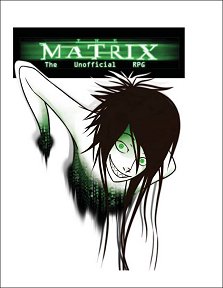
The foreword explains how the game was born, out of a fascination with cyberpunk ideas of people and technology blending and blurring together, from novels by William Gibson and Neal Stephenson to the Matrix movies themselves. Design of the mechanics was influenced by a dislike of the sometimes obsessive focus on die rolling and precise details of character stats to the detriment of the shared storytelling experience.
The introduction sets the scene: true Matrix-style explanation of how all that you think you know is actually not real but a computer-generated illusion... but some people are curious or awkward enough to be able to crack through to see the underlying reality. This is followed by The Setting which goes into more detail about the Matrix as neural interactive simulation. If you are familiar with the movie, this ought to be quite straightforward, if you are not, watching it might be a good idea round about now! Otherwise things may get a little confusing...
To aid in dispelling (or creating?) confusion we next have some History, covering what has happened since Machines took over and imprisoned almost everybody in the Matrix... mostly war between man and machine, interspersed with the struggle to survive outside the safety of the Matrix with Earth being enshrouded in an Ice Age.
Scene set, we move on to Concepts. Here the game mechanics are explored. Based on D10s, players accumulate dice pools which are rolled for task resolution. Each die that rolls 8+ is classed as a success, the GM determines how many successes are required for the character to accomplish the task in question. A 1 is an automatic failure, but only becomes problematic if the number exceeds the number of successes rolled. The character's Skills and Attributes are used to determine how many dice are in the dice pool for the task to be attempted. In general, an average task will need 2 successes, a hard one 3 and an extreme one 4... within the Matrix, things are a bit different, for gifted characters very little is completely impossible if they can but imagine it! This clear, there's a brief discussion on taking damage followed by explanation of skill levels which have to be learned or, in the Matrix, downloaded. So far we haven't heard about the attributes... Whilst the mechanics are quite straightforward, a little more organisation might make the presentation clearer.
Combat is next, and at least it's provided with plenty of examples (printed in green so they stand out from the rest of the text, a neat idea). And finally, we get to those attributes, which are different for AIs (it's suggested that these are only NPCs), for humans and for a human's Matrix Ego. There's an interesting concept called CyberZen - if this reaches 10, a character can purchase The Gift and become like Neo, able to manipulate things within the Matrix. That's when things get fun!
Next comes the actual mechanics of character creation. Many games handle that first, then you find out what you can do with it, the other way around is an interesting approach as you have some idea of what you are going to need to create the character you have in mind before you need to start worrying about how to generate him. It is a simple point-buy system, so you can begin to customise your character to suit your initial concept. There are various types of characters that can be played, and the discussion moves on to describe them. Think of these as 'character classes' but the distinctions are somewhat blurred.
An extensive and detailed list of skills comes next. Choose wisely. There are also a series of Matrix Feats which are manipulated using CyberZen. This is followed by an equipment list, divided into Real World and Simulacra - for use within the Matrix, they don't work in the real world. And of course there are weapons. Plenty of weapons. And vehicles.
The work finishes with an extensive Glossary, a GM Screen (well, the information panels you could put on one, or otherwise use as a quick reference), and a blank character sheet.
That's it... for now, at least. It's a work in progress so keep an eye on the website for upgrades. What there is little of is any idea about what sort of adventures you could run. Helping people escape from the Matrix is an obvious one, of course, and then you can use the history section to work out some of the real world conflicts and intrigues that they can then get embroiled in. Promising, but with some way to go before it becomes a fully-fledged game. Excellent start, though, and the mechanics are simple but sound!
Return to The Unofficial Matrix RPG Corebook page.
Reviewed: 16 May 2013

